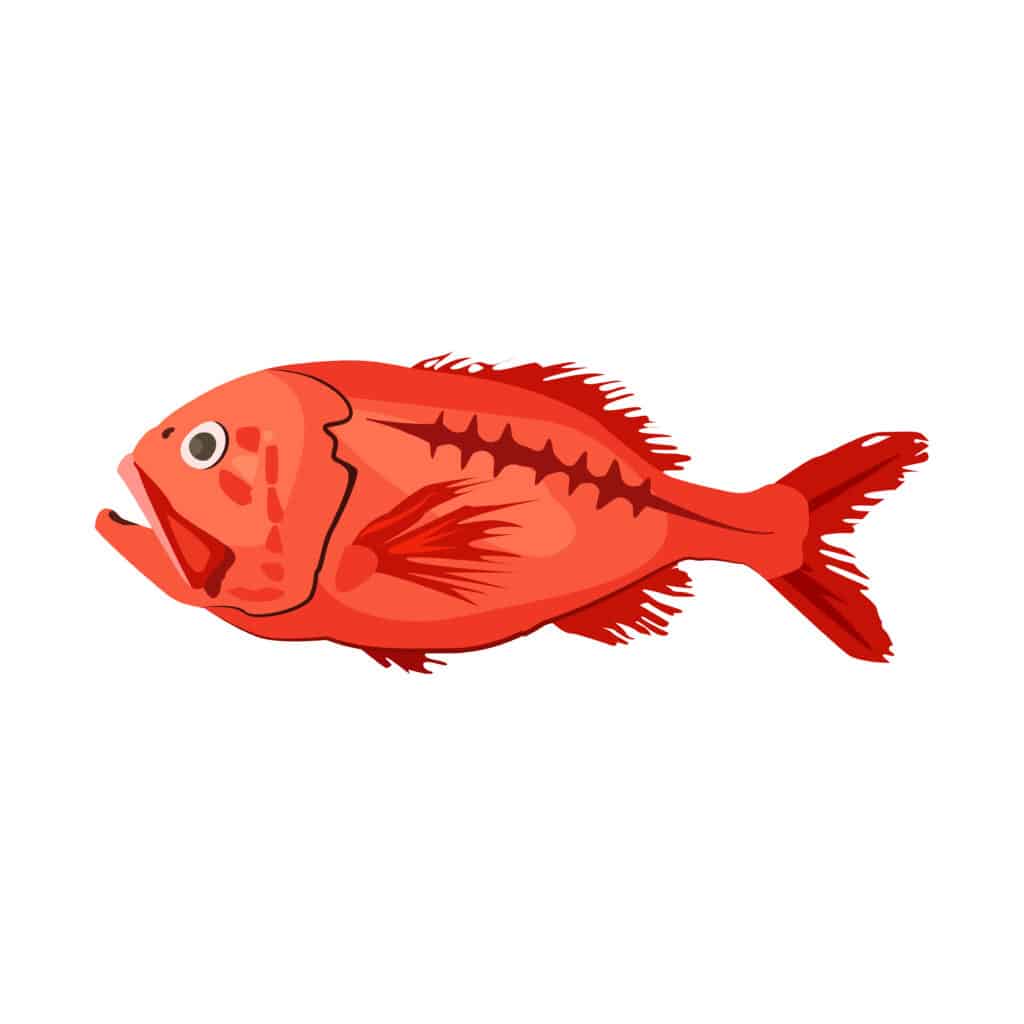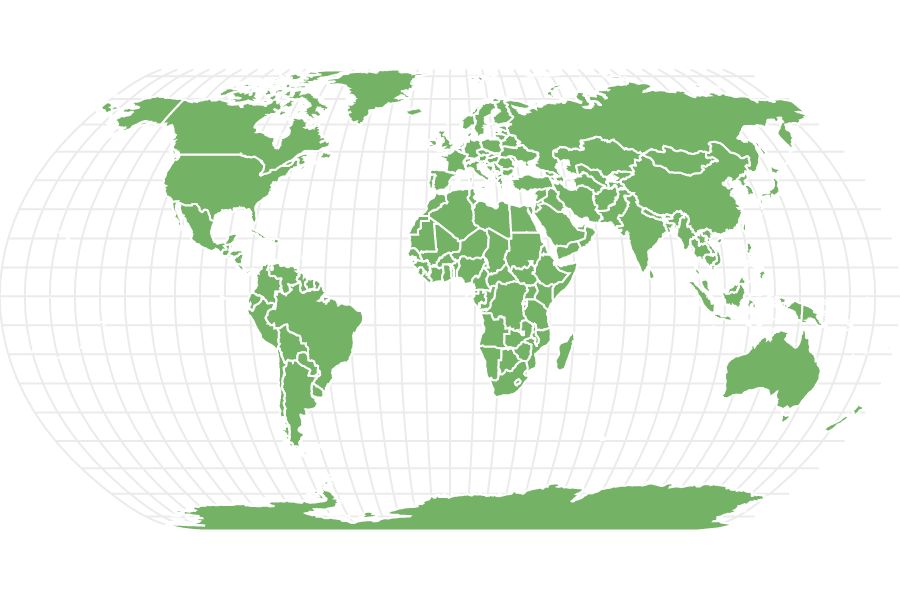Orange Roughy
Hoplostethus atlanticus
One of the oldest commercially harvested fish
Advertisement
Orange Roughy Scientific Classification
- Kingdom
- Animalia
- Phylum
- Chordata
- Class
- Actinopterygii
- Order
- Trachichthyiformes
- Family
- Trachichthyidae
- Genus
- Hoplostethus
- Scientific Name
- Hoplostethus atlanticus
Read our Complete Guide to Classification of Animals.
Orange Roughy Conservation Status
Orange Roughy Facts
- Prey
- Zooplankton, crustaceans, fish, and squid
- Main Prey
- Shrimp, krill, fish, and squid
- Name Of Young
- Fry
- Group Behavior
- School
- Fun Fact
- One of the oldest commercially harvested fish
- Biggest Threat
- Overfishing
- Most Distinctive Feature
- Head riddled with muciferous canals
- Distinctive Feature
- Bright orangish-red scales
- Other Name(s)
- Red roughy, slimehead, deep sea perch
- Average Spawn Size
- 22,000
- Habitat
- Seamounts and other undersea geological structures
- Predators
- Sharks, snake mackerels, cutthroat eels
- Diet
- Carnivore
- Lifestyle
- School
- Favorite Food
- Fish and crustaceans
- Special Features
- Don't reach sexual maturity until around 20 years old
- Number Of Species
- 1
- Location
- Pacific, Atlantic, Indo-Pacific
Orange Roughy Physical Characteristics
- Color
- Yellow
- Red
- Blue
- Black
- White
- Orange
- Skin Type
- Scales
- Lifespan
- Up to 250 years
- Weight
- Maximum of 15 pounds
- Length
- Up to 30 inches
- Age of Sexual Maturity
- 20-40 years old
- Venomous
- No
- Aggression
- Low
View all of the Orange Roughy images!
Summary
Able to live over 200 years, the orange roughy is a deep-sea fish belonging to the slimehead family Trachichthyidae. They mature extremely slowly, which makes them highly susceptible to overfishing. They possess rounded heads covered in mucous-filled canals, hence their name. When active or feeding, they tend to appear orangish-red, but they slowly lose their pigmentation when resting.
5 Orange Roughy Facts
- The oldest ever caught had an estimated age of 250 years old.
- Orange roughy tend to congregate near seamounts and other undersea structures with high levels of water movement and ample prey.
- Juveniles and adults appear to practice resource partitioning, wherein they avoid competing with one another for the same food source at specific depths.
- Females produce roughly 10% as many eggs compared to other fish their size, typically laying only 22,000 eggs per kilo of body weight.
- In the 1970s, fisheries stopped referring to orange roughy as slimeheads in order to make them more marketable as commercial fish.
Limpet Classification and Scientific name
They are a member of the slimehead family Trachichthyidae. In addition to the orange roughy, it is also known as the red roughy, deep sea perch, or simply slimehead. Its family name derives from the Greek words trachys, meaning “rough,” and ichthys, meaning “fish.” Slimeheads feature a network of muciferous canals running throughout their head, hence their name. They belong to the genus Hoplstethus, which derives from the Greek words hoplo, meaning “weapon” or “tool,” and stethus, meaning “breast.” Taken literally, the genus name translates as “to prick a little breast.”
Meanwhile, its scientific name, atlanticus, has two alternate meanings. In Latin, atlanticus translates to “of or pertaining to the Atlantic Ocean,” which may refer to its geographic distribution. While they live in the eastern Atlantic Ocean, you can also find orange roughy throughout the western Pacific, eastern Pacific, and Indo-Pacific. In Greek, atlanticus takes on an alternate meaning, namely “Atlantean” or “of Atlantis.”
Orange Roughy Appearance

In addition to the orange roughy, it is also known as the red roughy, deep sea perch, or simply slimehead.
©PCH.vector/Shutterstock.com
As its name implies, the orange roughy isn’t known for its beauty. It possesses a rounded head covered with muciferous canals, hence the name slimefish. The dorsal fin consists of 4 to 6 shark spines and between 15 and 19 soft rays. Meanwhile, the anal fin contains approximately 3 spines and 10 to 12 soft rays. They have a large, bluish-black mouth, rather large eyes and reddish-orange scales, but they can change color based on their activity level. They lose almost all of their pigmentation during long periods of inactivity until they appear predominantly yellowish-white. With a maximum recorded length of 30 inches and weight of 15 pounds, orange roughy rank as the largest known slimehead species. That said, most specimens measure between 14 and 18 inches on average.
Orange Roughy Distribution, Population, and Habitat
You can find them throughout the eastern and western Pacific, eastern Atlantic, and Indo-Pacific. Well-studied stocks include the populations around Australia, New Zealand, and Namibia, all of which operate established commercial fisheries for orange roughy. In the eastern Atlantic, they are most common off the coast of Chile. As adults, they tend to aggregate in schools of approximately 1 to 2.5 fish per square meter. They frequently congregate along the sea bed near geological structures such as seamounts and canyons. Researchers suspect that the water mixing and movement in and around these structures leads to higher concentrations of prey, which in turn attracts orange roughy and other predators. They prefer cold water between 37 and 48 degrees Fahrenheit. They are bathypelagic, meaning they spend most of their lives at considerable depths, often in the range of 590 to 5,910 feet below sea level.
Orange Roughy Predators and Prey
Several species prey on orange roughy as juveniles and adults. Common predators of orange roughy include sharks, snake mackerels, merluccid hakes, and cutthroat eels. As for prey, the diet of orange roughy varies depending on their age and depth. Juveniles typically feed on zooplankton, shrimp, krill, small fish, and crustaceans. Meanwhile, adults primarily feed on small fish, such as Butterflyfish and Lanternfish, as well as crustaceans and squid. Orange roughy partake in a phenomenon known as resource partitioning, which consists of juveniles and adults not competing for the same food sources. For example, juveniles tend to consume more crustaceans as they decrease in depth, while adults eat fewer crustaceans at lower depths. Similarly, juveniles eat more fish close to the surface, while adults eat mostly fish and squid at lower depths.
Orange Roughy Reproduction and Lifespan
Orange roughy reproduce via broadcast spawning by releasing large, spherical eggs and sperm into the water. The eggs take around 10 to 20 days to fertilize and hatch, at which point the orange roughy larvae rise closer to the surface to develop. Although orange roughy make annual migrations, they do not breed every year. In fact, most orange rough do not reach sexual maturity until they are at least 20 years old, and some don’t breed until they reach 30 or 40 years old. In addition, females produce relatively fewer eggs compared to other fish their size. Generally speaking, a female releases approximately 22,000 eggs per kilo of body weight, which represents only about 10% of the average number of eggs produced by similar-sized fish. Throughout her lifetime, the average female may only lay around 90,000 eggs.
One of the most marvelous things about orange rough is their incredible lifespan. As previously mentioned, orange roughy mature incredibly slowly. They go through metabolic phases that include high activity and feeding followed by low activity and rest. This metabolic shifting likely contributes to the orange roughy’s ability to live for so long. Researchers use several methods to estimate the age of orange roughy, including radiometric dating of trace isotopes and counting growth rings in the ear bones or otoliths. Depending on the method used, researchers estimate that orange roughy can live well over 200 years old. The oldest specimens ever caught were estimated at approximately 250 years, making them the commercial fish species with the longest life expectancy.
Orange Roughy in Food and Cooking
Up until the 1970s, almost no one frequently ate them. Before then, people knew orange roughy as slimefish, which made them sound understandably unappetizing. However, all that changed thanks to a U.S. National Marine Fisheries Service campaign to rename them to make them more marketable to consumers. The campaign worked, and the commercial fishing of them took off. Every year, fisheries harvest thousands of tonnes of orange roughy from the world’s oceans, primarily through the use of bottom trawling.
Orange roughy has a mild and flaky texture with white or brown flesh. You can prepare it in numerous ways, including grilled, fried, baked, sauteed, or steamed. It pairs well with just a little lemon, fresh herbs, butter, and olive oil, all of which can enhance the flavor or prevent it from frying out too quickly. Orange roughy contains high levels of omega-three fatty acids, protein, vitamins A and D, and calcium while having relatively low levels of fat. At the same time, orange roughy can also have high levels of mercury. Mercury is a natural toxin that can affect brain development and kidney and nervous system health if ingested in large quantities.
Orange Roughy Population
For millions of years, orange roughy went almost completely unnoticed as they lived out their long lives along the sea floor. However, all that changed in 1975 when scientists discovered large aggregations of orange roughy off New Zealand during a deep-sea research expedition. In the following years, commercial fisheries began targeting them in earnest due to their pleasant taste and the relative ease with which they can be caught. Unfortunately, they are ill-equipped to overcome the challenges posed by commercial fishing due to their slow rate of growth and low fecundity.
In just a few short decades, several orange roughy populations declined precipitously due to overfishing. Stocks around New Zealand and Australia have seen the worst declines, and 3 out of 8 of New Zealand’s fisheries closed due to depleted stock by the 1990s. In response, numerous countries, including Australia and New Zealand, took steps to regulate fishing to maintain healthy stocks. Today, the IUCN lists the orange roughy as a Vulnerable species in recognition of the steep decline in stocks across the Indo-Pacific and elsewhere. Despite this assessment, fisheries continue to operate not just in Australia and New Zealand but around the world. Several previously closed fisheries have since reopened in recent years, and it remains to be seen whether regulations designed to protect orange rough stocks will actually manage to shelter populations long-term from the effects of commercial fishing.
Related Animals
View all 66 animals that start with OOrange Roughy FAQs (Frequently Asked Questions)
Are orange roughy carnivores, herbivores, or omnivores?
Orange roughy are carnivores that eat different marine animals depending on their age and depth. Their diet includes zooplankton, fish, crustaceans, and squid.
Where are orange roughy found?
You can find orange roughy in the western Pacific, eastern Atlantic, eastern Pacific, and Indo-Pacific. They tend to congregate near seamounts, undersea canyons, and other geologic structures along the ocean floor.
What are the drawbacks of eating orange roughy?
Orange roughy contain little fat and a lot of protein but can also have high levels of mercury. Ingesting high levels of mercury can affect your kidney and nervous system health and may also impair brain development, particularly in young children.
Why can’t I find orange roughy anymore?
The orange roughy stocks around New Zealand and Australia have been severely depleted, as they were the first populations targeted by commercial fisheries. Orange roughy mature very slowly, and these populations have not had enough time to replenish their numbers since they were excessively overfished.
Thank you for reading! Have some feedback for us? Contact the AZ Animals editorial team.
Sources
- , Available here: https://www.iucnredlist.org/species/155168/45884209
- , Available here: https://www.afma.gov.au/western-orange-roughy-research-plan
- , Available here: https://www.marineconservation.org.au/orange-roughy-research-shows-long-lived-fish-must-be-left-to-recover/
- , Available here: https://sustainablefisheries-uw.org/fishery-feature/orange-roughy/
- , Available here: https://ocean.si.edu/ocean-life/fish/rough-going-orange-roughy
- , Available here: http://orange-roughy-stories.msc.org/
















